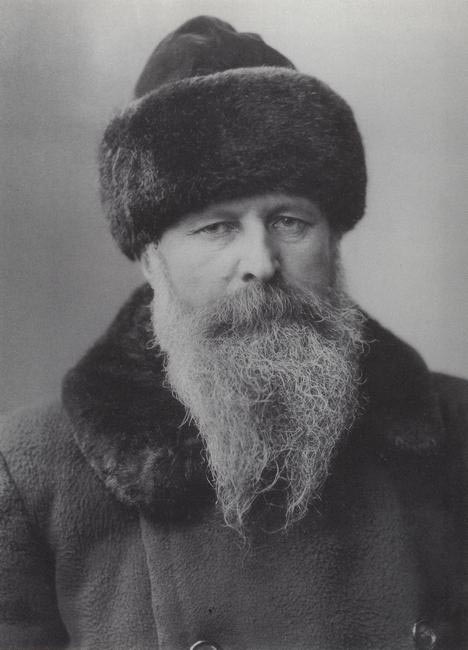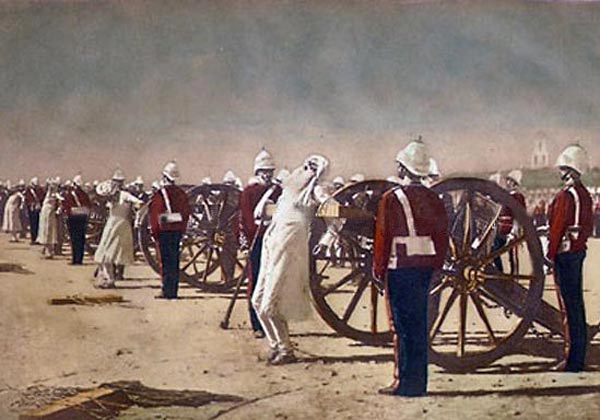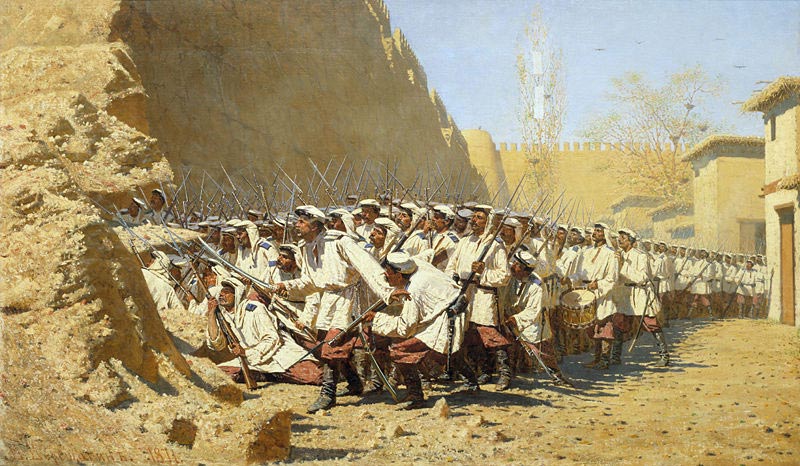| Vasily Vereshchagin | |
|---|---|
 |
|
| Born | October 26, 1842 Cherepovets, Novgorod Governorate, Russia |
| Died | April 13, 1904 (at age 61) Port Arthur, Manchuria |
| Nationality | Russian |
| Education | St. Petersburg Society for the Furtherance of the Arts Jean-Léon Gérôme |
| Field | Painting |
| Works | View Complete Works |
Vasily Vereshchagin was a Russian painter who specialized in war scenes. He was one of the first Russian painters to achieve significant fame outside his home country. A number of Vereshchagin’s artworks were never shown in public during his lifetime because of the harsh realism of his style. He was often controversial in Britain, due to his depiction of that country’s sometimes brutal colonial rule in India.
Personal Life
Vereshchagin was born in the city of Cherepovets in the Vologda region of Russia. His father was a landowner, and his reasonably prosperous background helped the young Vasily to gain entry into the Junior Cadet Corps at the age of eight. The following year, 1853, he was enrolled at the Naval School in St. Petersburg, where he discovered his love of drawing. He started to attend the St. Petersburg Society for the Furtherance of the Arts in 1858. This, along with good reports from his school teachers, made Vereshchagin want to become a professional artist.
 Despite graduating from Naval School in 1860, Vereshchagin was determined to follow his artistic dreams. He enrolled in the Academy of Arts instead of continuing his naval career. This enraged his father so much that he stopped supporting him, leaving the teenager to make his own way in the world. He threw himself totally into his art and never married. In later life, however, he maintained some links with the military beyond simply depicting the horrors of war. This would eventually cost Vereshchagin his life: he was a guest of Admiral Makarov during the Russo-Japanese war in 1904 when the ship he was on was torpedoed.
Despite graduating from Naval School in 1860, Vereshchagin was determined to follow his artistic dreams. He enrolled in the Academy of Arts instead of continuing his naval career. This enraged his father so much that he stopped supporting him, leaving the teenager to make his own way in the world. He threw himself totally into his art and never married. In later life, however, he maintained some links with the military beyond simply depicting the horrors of war. This would eventually cost Vereshchagin his life: he was a guest of Admiral Makarov during the Russo-Japanese war in 1904 when the ship he was on was torpedoed.
Artistic Development
 Vereshchagin soon became unhappy with the traditional, inflexible methods advised by the Academy of Arts. Eventually, he became so frustrated that he deliberately destroyed one of his works in protest. By 1863, he had quit the Academy entirely, traveling to the Caucasus region to “learn from Nature.” This visit influenced his early work considerably, with many of the scenes he painted in the following years being pictures of landscapes in the region. Several years later, he watched workmen hauling barges and decided to depict their misery in art. The painting he planned, however, was never finished.
Vereshchagin soon became unhappy with the traditional, inflexible methods advised by the Academy of Arts. Eventually, he became so frustrated that he deliberately destroyed one of his works in protest. By 1863, he had quit the Academy entirely, traveling to the Caucasus region to “learn from Nature.” This visit influenced his early work considerably, with many of the scenes he painted in the following years being pictures of landscapes in the region. Several years later, he watched workmen hauling barges and decided to depict their misery in art. The painting he planned, however, was never finished.
1867 saw a highly significant turning point in Vereshchagin’s development. He traveled to see the conflict in Turkestan, and not only observed the war but played an active role. As part of a garrison defending a fortress in Samarkand, he was awarded a medal for his bravery. Vereshchagin returned to Turkestan two years later, spending considerable time learning about its customs and traditions. He used this information to paint a series of works showing life in central Asia. Vereshchagin found the region colorful and full of life, but he was keenly aware of its poverty and social problems, painting several pictures of beggars and slave markets.
 From this point on, he focused most of his effort into battle paintings. Increasingly, these showed war as the brutal business it really was, rather than the idealized, romantic version depicted by most earlier artists. He ranged widely within this subject, painting both contemporary and historical scenes. Vereshchagin painted everything from the execution of rebels in India to the crushing defeat of Napoleon’s army in Russia. He vividly portrayed the cold, hunger, and fear which the ordinary soldiers of these armies felt so keenly. He was deeply unhappy with their treatment at the hands of their feudal lords.
From this point on, he focused most of his effort into battle paintings. Increasingly, these showed war as the brutal business it really was, rather than the idealized, romantic version depicted by most earlier artists. He ranged widely within this subject, painting both contemporary and historical scenes. Vereshchagin painted everything from the execution of rebels in India to the crushing defeat of Napoleon’s army in Russia. He vividly portrayed the cold, hunger, and fear which the ordinary soldiers of these armies felt so keenly. He was deeply unhappy with their treatment at the hands of their feudal lords.
Notable Artworks
Among Vereshchagin’s early battle paintings are a pair of linked pieces, At the Fortress Wall and They Entered. These works, painted in the early 1870s, show the assault on the fortress of Khiva in Uzbekistan. The first painting, At the Fortress Wall, shows a column of anxious but disciplined Russian troops starting their attack. The second piece, They Entered, shows the aftermath of the assault: men lie dead on the ground and the survivors are walking wearily off into the distance. There is little sense here of the well-drilled force seen in the earlier painting; instead, war is seen as vicious and uncaring.
Vereshchagin’s paintings of British India became notorious, especially Suppression of the Indian Revolt, painted in 1884. This work shows convicted mutineers being executed by the brutal method of firing them from field guns. Many people deny that this ever happened, saying that the men were simply shot or hanged. Another portrayal of India under British rule can be seen in The State Procession of the Prince of Wales into Jaipur. This enormous painting, among the largest in the world, takes a documentary approach. Viewed from a distance, it has many similarities with a modern photographic record.